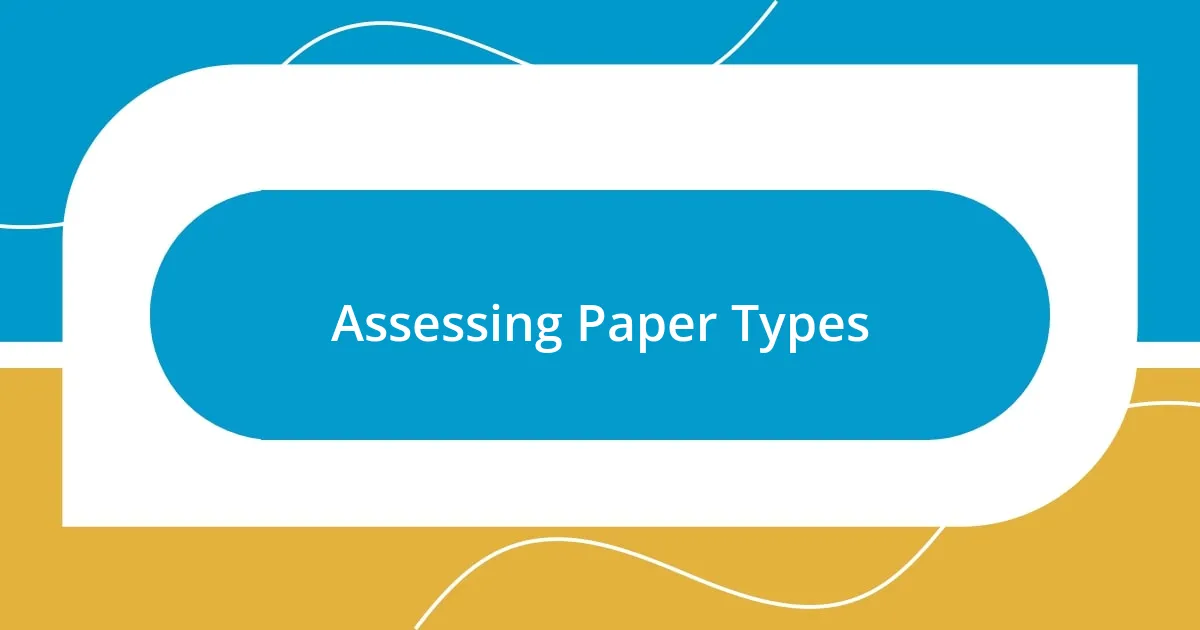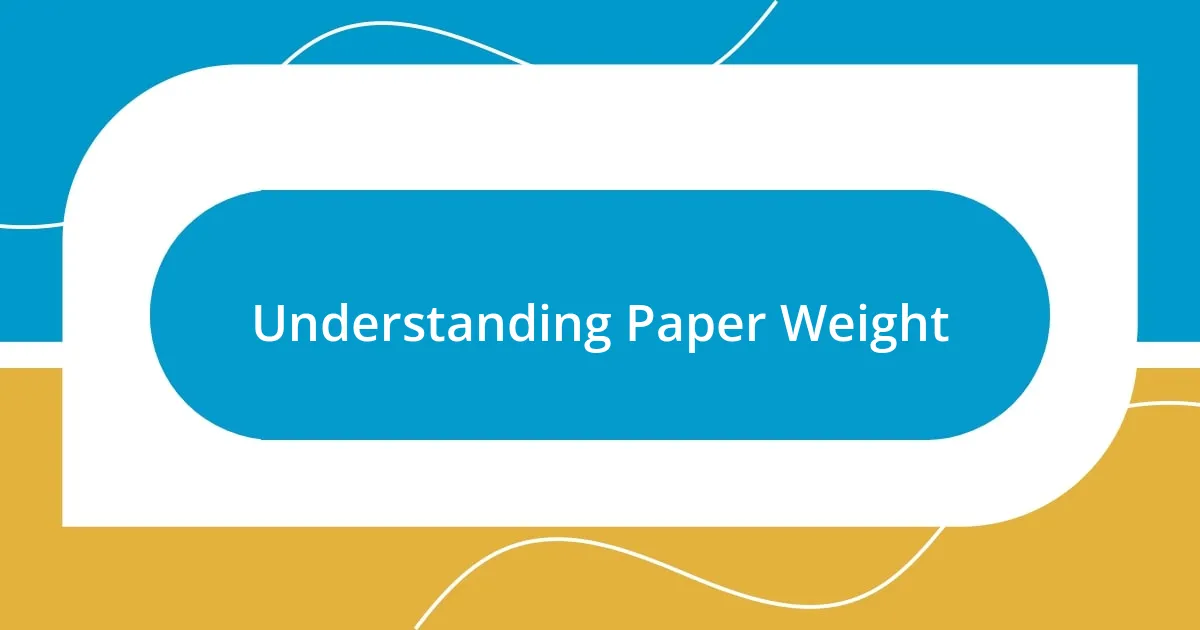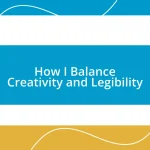Key takeaways:
- The feel, weight, and thickness of paper significantly influence the creative process and overall perception of projects.
- Choosing the right texture and finish, such as matte or glossy, shapes emotional responses and enhances viewer engagement.
- Color selection is crucial for setting the tone and conveying specific emotions, influenced by psychology and cultural meanings.
- Embracing eco-friendly options can align personal values with aesthetics, contributing positively to sustainability while also captivating audiences.

Assessing Paper Types
When I assess paper types, the feel often speaks volumes. For instance, working on a particularly creative project, I chose a textured watercolor paper, and the difference in the experience was palpable. I could actually sense the artistic potential in each stroke, igniting my creativity in ways plain paper just didn’t. Don’t you just love when the medium inspires the message?
In my experience, weight and thickness can also dramatically affect the outcome of a project. I remember printing a book on a heavier cardstock, believing that durability would enhance the overall feel. The weight added a level of professionalism that left both me and my readers feeling that the content was something special. Have you ever noticed how the right texture can elevate an entire piece?
Furthermore, the finish—glossy, matte, or uncoated—can shift the aesthetic drastically. While I tend to lean towards matte for a more subdued look, I once experimented with glossy paper for a vibrant photo collection. The colors popped in a way that was truly breathtaking. So, what finish resonates with your vision? Finding the right paper type is just as much about the intention behind your project as it is about the properties of the paper itself.

Understanding Paper Weight
Understanding the weight of paper is crucial in achieving the right results for any project. I vividly recall experimenting with different weights when I was designing invitations for a friend’s wedding. The moment I held a thick, plush cardstock in my hands, I felt an immediate sense of elegance and quality that lighter paper just couldn’t deliver. It’s fascinating how something as simple as weight can influence perception and set the tone before the content is even read.
Here are some essential points to consider about paper weight:
- Measurement: Paper weight is typically measured in grams per square meter (GSM) or pounds (lbs). A higher number indicates thicker, heavier paper.
- Common Weights: Standard copy paper usually falls around 70-80 GSM (20lbs), while cardstock can range from 200 GSM (about 90lbs) to 400 GSM (over 200lbs).
- Functionality: Heavier paper works well for projects requiring durability, like business cards and invitations. Lighter paper is better suited for everyday tasks, like printing documents and flyers.
- Flexibility: Thicker paper can be more rigid but may not fold as easily, which is something to keep in mind for brochure designs.
Understanding paper weight transforms how I approach projects. It’s remarkable how a specific weight can evoke emotions or elevate a message—like when I unwrapped my artist friend’s portfolio printed on heavyweight paper, instantly feeling the gravity and importance of their work. The choices we make matter, and weight is a significant player in that narrative.

Evaluating Texture and Finish
Evaluating the texture and finish of paper is something I’ve always found pivotal in achieving the right look and feel for any project. I remember an instance when I was preparing a portfolio for an art exhibition, and I chose a soft-touch finish. This subtle texture added a level of sophistication that made the entire presentation feel luxurious. It’s incredible how a simple decision about texture can transform not just the look but the experience of the viewer. Have you ever touched a paper that felt like silk? It’s a sensory delight that makes you want to explore further.
When it comes to finishes, my personal experience has taught me the importance of matching the finish to the project’s intent. For example, while designing a promotional mailer, I opted for an uncoated finish to convey a more organic and approachable vibe. It was a stark contrast to a past project where I used a high-gloss finish for a tech brochure that screamed modernity and sleekness. Each decision reflects not just a taste but also an understanding of how texture and finish affect emotional response. Isn’t it fascinating how these choices weave into the narrative of a project?
Finally, I can’t overlook the aspect of surface texture, which can vary from smooth to rough. For instance, while making handmade greeting cards, I chose a rougher textured paper that provided a tactile experience, inviting recipients to engage not just visually but also with their hands. This contrasts with the smooth, fine papers I often select for professional presentations that require a polished look. In my experience, the right texture invites connection, whether it’s the bristly feel of linen cardstock or the airy touch of recycled paper. How do you envision your audience interacting with the textures you choose?
| Texture/Finish | Description |
|---|---|
| Matte | Non-reflective finish, soft to the touch; ideal for subtle elegance. |
| Glossy | Highly reflective finish, vibrant colors; great for eye-catching designs. |
| Textured | Surface has character (e.g., linen, laid); adds depth and personality. |
| Uncoated | Raw paper feel, allows for easy writing; perfect for organic designs. |

Importance of Paper Color
Choosing the right paper color can profoundly impact the overall perception of a project. I remember vividly a time when I was designing birthday invitations for my niece. I initially gravitated toward a bright yellow, thinking it would convey joy. But once I tried a soft pastel pink, I was amazed at how much more inviting and sweet it felt, perfectly matching the spirit of the celebration. It truly is fascinating how color can resonate emotionally and set the mood before anyone even reads the text.
In my experience, the psychology of color plays a huge role in design. For example, when I created a flyer for a local charity event, I opted for a soothing blue background. The calming effect of blue not only captured attention but also communicated trust and reliability, which was essential for a charitable cause. Have you ever considered how your color choices might evoke specific feelings or perceptions? It’s an immediate connection that can either draw people in or push them away.
I also can’t help but think about how cultural connotations influence paper color choices. When I printed wedding programs, I chose an elegant cream, which I felt conveyed tradition and sophistication. A colleague suggested deep red instead, and though it seemed bold, it ultimately represented love and passion perfectly. This made me realize how color can be a conversation starter, leading to explorations of meaning and intent. What colors resonate with you in particular projects? There’s so much depth to consider in those seemingly simple choices.

Choosing Eco-Friendly Options
Choosing eco-friendly options is something I’ve really embraced in my paper selection process. One time, while creating packaging for handmade soaps, I stumbled upon a beautiful recycled kraft paper. Not only did it give a rustic charm that felt authentic, but it also aligned with my values of sustainability. It felt rewarding knowing that my choice was not just aesthetic but also beneficial for the environment. Have you ever felt that thrill of making a responsible choice?
When I switched to eco-friendly paper for my business cards, I was surprised by the variety available. I remember being blown away by the texture of the tree-free paper made from cotton. It felt luxurious in my hands and was a conversation starter. People not only appreciated the card’s quality but also the eco-conscious dedication behind it. Isn’t it amazing how such choices can elicit curiosity and enthusiasm from others?
Even in my day-to-day printing tasks, I prioritize eco-friendly options. I often choose papers bearing certification marks, such as the FSC label, ensuring that the forests are managed responsibly. It gives me peace of mind that my work supports sustainability. What about you? Are you considering the environmental impact of your paper choices? I hope you find inspiration in exploring the options available that benefit both your projects and the planet.

Matching Paper to Purpose
When it comes to matching paper to purpose, I always reflect on the intended outcome of my project. For example, while working on a scrapbook for my family’s reunion, I remember choosing a textured linen paper for my photos. Its tactile quality added an element of warmth that made the memories feel even more special. I thought, how fitting is it to have a medium that resonates with the love shared in those captured moments?
In another instance, while designing marketing materials for a tech startup, I opted for a sleek, glossy paper. I aimed to convey innovation and professionalism, aligning the finish with the cutting-edge vibe of the brand. Sometimes, it’s just a matter of picking up the right paper and feeling that immediate connection. Have you ever noticed how the texture or finish can completely alter the way your message comes across?
Moreover, I’ve discovered that different projects require different weights of paper, which can significantly influence the perception of quality. One time, I printed invitations for a formal event on a heavy cardstock that exuded elegance and importance. The guests commented on the quality the moment they received them, confirming my choice was spot on. Isn’t it fascinating how something as simple as weight can elevate an entire experience? Understanding these subtleties has shaped my approach to paper selection immensely.














